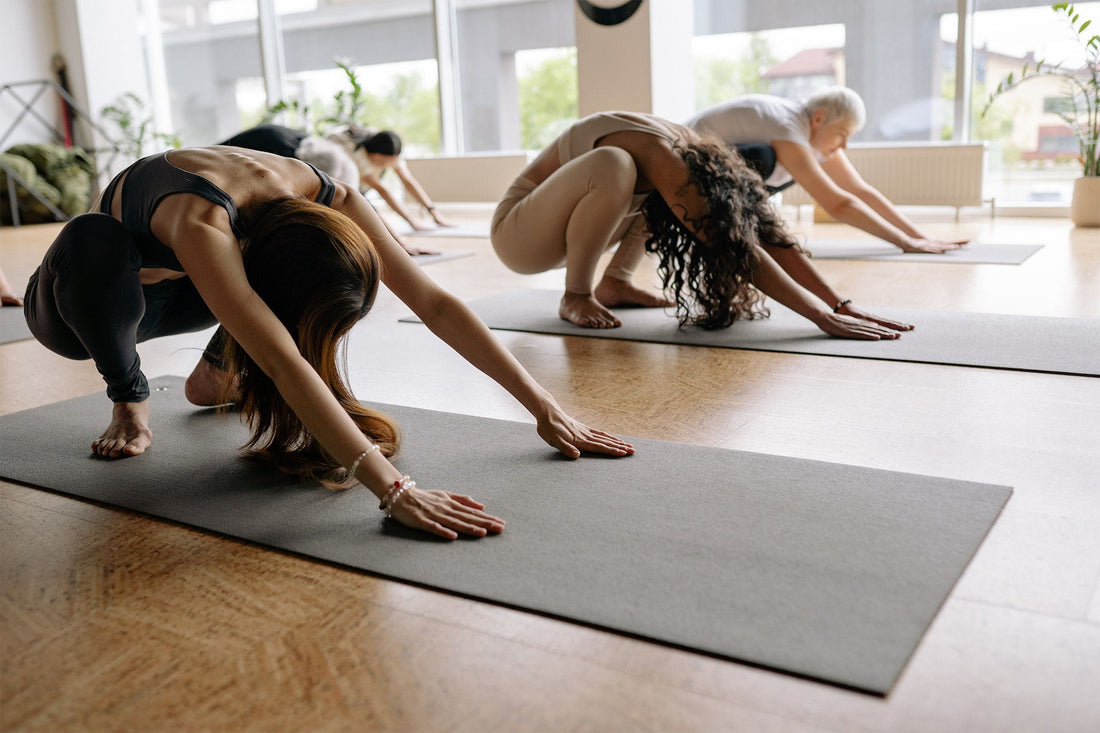Seventeen years ago, there was just one basic type of yoga mat: PVC, and only color options were purple or blue. But these days, yoga mat are available in a variety of colors, patterns and materials.
Whether you are a total beginner or a long-time enthusiast, having the appropriate yoga mat can make a whole world of a difference to your practice. With a multitude of mats available in the market, it could be difficult to pick the right one.
Aside from a color and pattern that complements your taste, your yoga mat should keep you stable in your poses; it should be storable and portable, yet comfortable and cushy. You could also want your mat to be eco-friendly. These components of your mat’s personality are all influenced by its construction: thickness, material, and surface texture.
While the vast majority of yoga mats are suitable for all styles of yoga, recognizing the distinctions can help you choose a mat that meets your requirements. Ready to unroll?

1.Thickness And Weight
The thickness of your yoga mat influences how pleasant it is - too thin, and your knee may be banged up during crescent lunge. Thick yoga mats (some as thick as 1/4 inch) might make it difficult to feel a solid connection to the floor, making you unstable in tree pose, for example.
A standard yoga mat is around 1/8 inch thick, while the thickest are approximately 1/4 inch. There are also wafer-thin yoga mats that are only 1/16 inch thick, marketed as “travel yoga mats.” They fold effortlessly and are light, making them ideal for packing in a luggage.

2.Materials And Durability
The material used to make your yoga mat determines its texture, stickiness, eco-friendliness, and sponginess (how much it responds to pressure), as well as how it wears over time.
The majority of standard yoga mats are made of PVC, sometimes known as vinyl. Natural and recycled rubber, jute, cork and organic cotton are newer, more eco-friendly options.
PVC, like other plastics, is created from petroleum, which is extremely harmful to the environment due to how it is extracted, manufactured, and wasted. It causes a lot of pollution in the air, water, and land, not to mention the carbon footprint of carrying it all over the world.
Cork is an excellent material for a yoga mat as it is 100% natural, hypoallergenic, naturally antibacterial, lightweight, and extremely resilient. Cork yoga mat features slip-resistant grips for extra stability, even in the hottest class. Cork trees store carbon naturally in order to rebuild their bark. Cork oak trees absorb up to 20 million tons of CO2 each year, reducing greenhouse emissions.

3.Texture
The traction provided by your yoga mat is determined by its texture. Texture, like stickiness, influences how much you slip and slide. It creates physical barriers against slippage (whereas stickiness relies on suction). Because texture impacts how a yoga mat feels, it is also a factor in overall comfort.
Any lumpy texture will certainly irritate you in a savasana if you’re a Princess-and-the-Pea-type. Texture can be man-made (for example, a pattern of raised bumps) or dictated by the materials - jute yoga mats have an inherent roughness to them, but PVC yoga mats, albeit slightly textured, have a gentler feel.
4.Eco-friendliness
As yogis , we hold dear the tenet of ahimsa, or non-violence. That makes practicing on a yoga mat that may eventually wind up filling a landfill for decades to come troublesome.
Natural materials, such as cork, jute or organic cotton, may also be used in the manufacture of sustainable yoga mats. If you care about the environment, avoid yoga mats made of PVC, which does not degrade in landfills and is difficult and expensive to recycle. While available in a variety of thicknesses, cork, jute and cotton yoga mats are thicker and slicker than PVC mats. You may get an sustainable yoga mat with a thickness that suits your demands for comfort and portability, as well as a texture that resists sliding.

5.Price
Yoga may be an expensive activity to participate in, which is rarely discussed. If you’re on a budget, you’ll want to be sure you’re getting a decent deal on your mat. However, if you want a mat that isn’t plain, standard-sized PVC, you’ll generally have to pay a little more money. Antimicrobial treatments and attractive designs aren’t as vital as substance and thickness, and they can raise the cost of your mat. If you are new to yoga, consider starting with a less expensive mat - you can always upgrade later!

